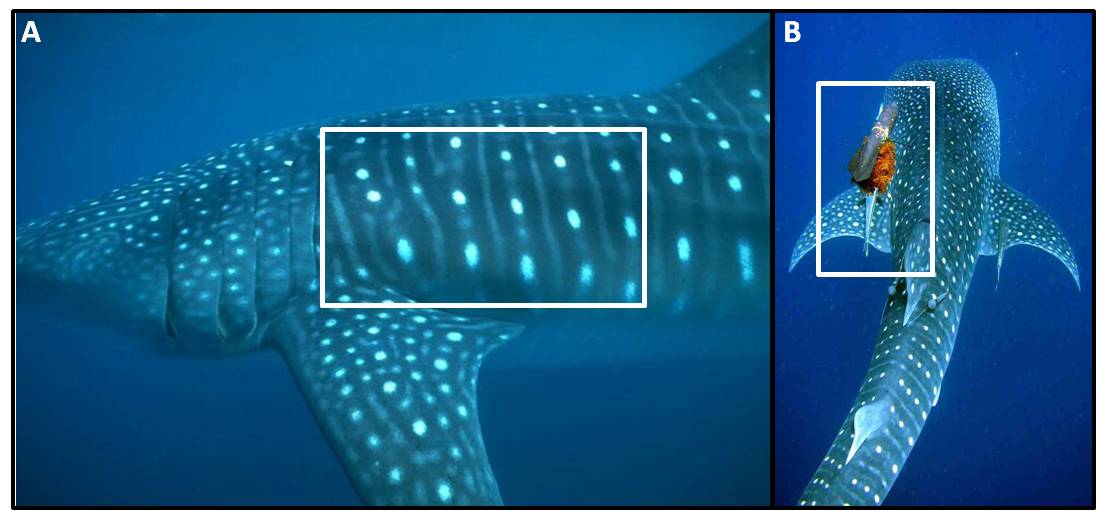Home > Browse by Institution > Australian Institute of Marine Science > Whale shark monitoring at Ningaloo
Whale shark monitoring at Ningaloo
- Australian Institute of Marine Science
- Australian Institute of Marine Science
Whale sharks (Rhincodon typus) are currently listed as Vulnerable species by the International Union for Conservation of Nature (IUCN), and as such it is essential that any monitoring techniques are as gentle as possible to ensure minimal impact on the animals. The most common techniques used for monitoring whale shark populations are variants of capture-mark-resight approaches, where animals are individually recognisable so that they can be followed through time. Individual recognition can be achieved by using an animal’s natural markings or by applying an artificial tag to an animal.
Ningaloo Reef is famous for the whale sharks that aggregate between April to August each year, and monitoring of these animals is ongoing using both natural markings (photo-identification) and artificial tags (satellite tags).
Photo-identification
Photo-identification is one of the most effective and popular methods of recording natural markings of an animal in that it permits individual identification, which can then allow the study of animal movement patterns, site fidelity, and population size. At Ningaloo Reef, the standard method of photographing whale sharks for photo-identification involves capturing images with digital cameras while swimming alongside the animal. The area on the flank of the whale sharks directly behind the 5th gill slit is typically chosen for use for identification (Figure 1A), and computer-assisted image matching software is used to match photos. In principle, the computer software constructs ‘fingerprint’ files that are used to identify individual whale sharks based on their spot pattern, in much the same way as human fingerprint studies.
Using the assumption that whale shark spot patterns remain stable through time, photo-identification of photos taken from 1992 to 2006 suggest the super-population of whale sharks participating in the Ningaloo Reef aggregation has been estimated at 300 to 500 individuals (~74 % male; ~16 % female; ~10 % unknown gender). At present, it is unknown whether the female component of the Ningaloo aggregation represents a small proportion of females that normally participate in a larger, sexually segregated female population that has yet to be identified.
Satellite tagging
Satellite tagging is a more expensive monitoring approach that provides information on the horizontal and vertical movement patterns of whale sharks over shorter time scales with greater geographical coverage. The satellite tags used to track movement patterns of whale sharks at Ningaloo Reef are SPLASH tags contained in a torpedo-shaped float that is attached to the shark's dorsal fin via a one-metre tether and fin clasp (Figure 1B). The fin clasps are covered with neoprene to reduce the risk of infection caused by friction of the clasp rubbing on the fin. The SPLASH tags transmit location (as precise as < 150 m), depth, and temperature data to satellites when the tag aerial and switch break the water surface.
A total of 19 SPLASH tags were deployed on whale sharks at Ningaloo between 2005 and 2008 – 7 of which reported position information at time scales of multiple weeks. Based on these tracks, it appears that when leaving Ningaloo Reef the whale sharks generally head south before migrating off on three broad trajectories into the Indian Ocean (see Google Earth layer below): a) a north-westerly direction into the open Indian Ocean toward Christmas Island; b) a northerly direction towards Sumatra and Java; and c) a north-easterly direction along the Western Australia coast towards the Timor Sea.
The information collected to date from the tracks therefore suggest that whale sharks do not appear to adopt random searching behaviours to maximize prey encounters, and that the Ningaloo super-population is part of a wider Indian Ocean whale shark stock that is likely to encompass much of the south eastern Indian Ocean and the waters of South East Asia.
For more detailed information on this study, see Meekan M, Speed C, Planes S, McLean C, Bradshaw C (2008), or contact the corresponding author, Dr Mark Meekan.
Dataset details
| Custodian | Dr Mark Meekan |
| Owner institution | Australian Institute of Marine Science (http://www.aims.gov.au/) |
| Spatial extent | Muiron Islands (21° 39' S, 114° 22' E) to Red Bluff (24° 01' S, 113° 25' E) |
| Data collection | 1992 to 2008 |
| Copyright | Copyright remains with the data owner(s) |
| Reference | Click here |








